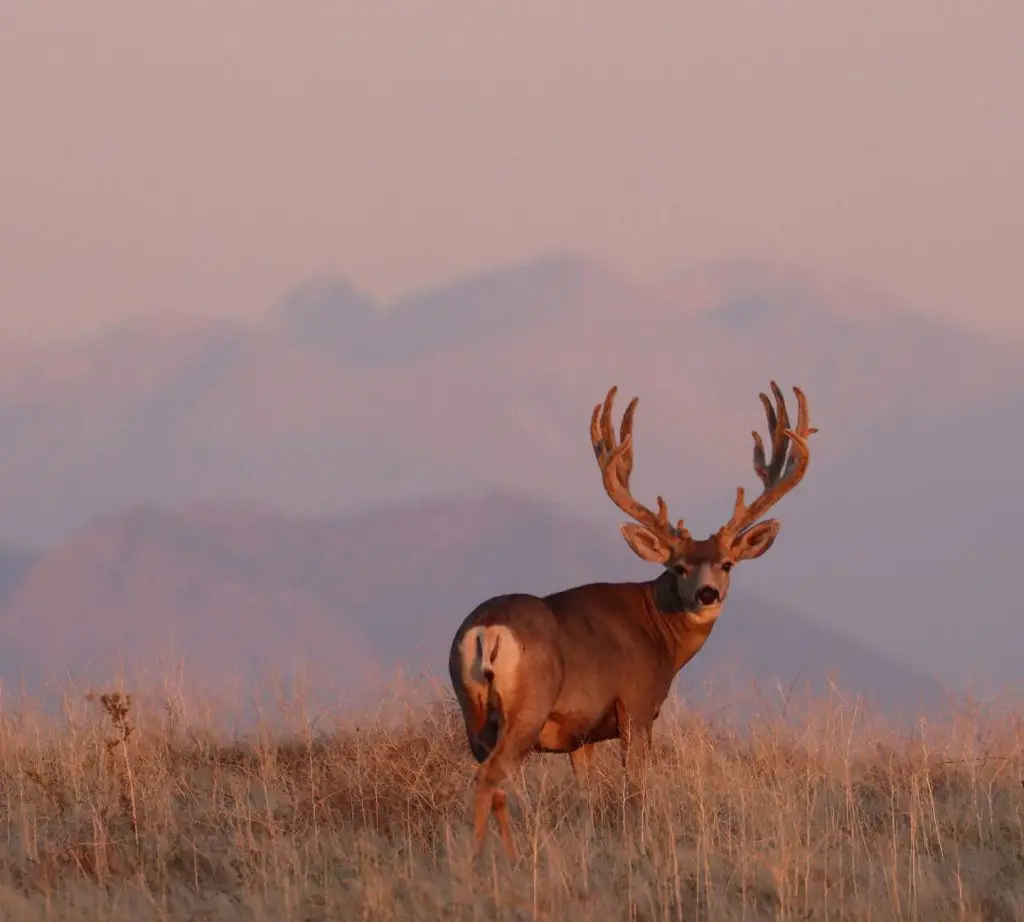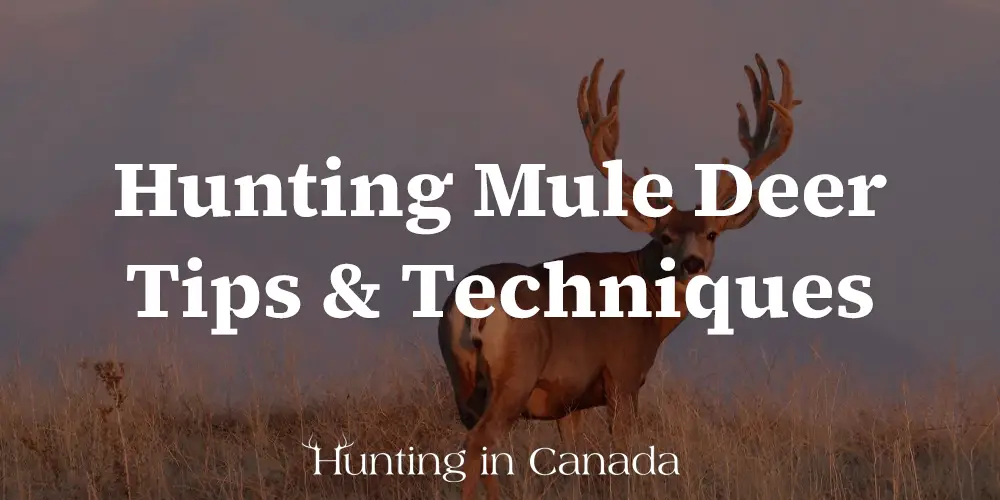If you are interested in hunting mule deer, then this article is for you. Mule deer are one of the most challenging big game animals to hunt, but it is also a fun, spot and stalk adventure. Mule deer hunting is a favourite pastime outdoor activity that hunters are eagerly waiting for year after year.
So If you have never gone mule deer hunting before, be ready for the greatest hunting experience of your life. In this article, we will mention some hunting tips and techniques that can increase your odds of bagging a trophy buck during the next mule deer season.
Where to Hunt Mule Deer?
The mule deer (Odocoileus hemionus) is found throughout North America, from Oregon and British Columbia in the West to western Texas and the Dakotas in the east, and from Mexico to Canada and Alaska.
There is a great mule deer hunting potential in New Mexico, Arizona, Colorado, Wyoming, Idaho, and Montana, and also the Canadian province of Alberta.
6 Tips for Hunting Mule Deer

1. Do Your Homework
Before the hunting season, spend some time poking around your unit using tools like Google Earth and OnX Maps. This is a great way to find public land boundaries, deer habitat, unpressured pockets, and where all those three factors overlap.
These animals are highly adaptable, so the mule deer habitat can take on a lot of various forms. But brushy landscapes are a frequently consistent factor. Deer are browsers, and they always seem to be concentrated in brushy landscapes.
Besides finding a great deer habitat, you also need to look for places where they can escape pressure. It does not necessarily mean going further into the backcountry. Sometimes going further from the roads can be a great option.
You can find good hunting opportunities in many areas. For instance, along private boundaries, in overlooked pockets near roads, or in those odd sites nobody bothers to hunt.
In the end, your aim is to find sites where all those factors overlap: great habitat, public land, and unpressured pockets. Before going home, take enough time to discover some of these sites and set up your plans.
2. You Must Be Patient
Whether it is bowhunting or rifle hunting, you must be patient. A mule deer hunter must always be on high alert and avoid sleeping while on a stand or drifting in space.
When the sun is up, mule deer prefer to stay in the shade. So you may have only one chance during the entire day, and you should be ready when it comes.
3. Learn How to Play the Wind
Mule deer rely heavily on their senses, they can catch your odour even when a mile away. Scent elimination can mask your presence, but the best way to be on the safe side is by staying downwind on the hunt. The wind may carry your scent, making the animal run away to safety before you take your shot.
4. A Vantage Point is Key
When it comes to mule deer hunting, the most challenging part is to find them. For that reason, a good vantage point is a key to success, especially when chasing mature mule deer bucks.
If possible, try to position yourself in a glassing location where you can see several basins at a time. This will improve your odds of finding a trophy mule deer.
5. Hunt All-Day
After you find a great habitat and a good vantage point, the next thing to do is to hunt all day. Position yourself at the glassing location before dawn and stay as long as you are able to glass.
Spending more time behind your spotting scope or binoculars will increase your chances of harvesting an animal. Mature bucks are primarily only active at dawn, dusk, and mid-day. They will stand up to stretch their legs or move a few feet. Always be ready for them, otherwise, you might miss the opportunity to harvest a mature mule deer buck.
6. Slow Down
Searching over shaded spots, basins, hillsides, and other nooks and crannies for a long time will strain your hope and your eyes.
Then suddenly, a buck will appear in your hunting area and you will switch into go mode. This is when you will find yourself rushing the opportunity and making mistakes. Next time try to stop and slow down. See what his behaviour is like, where he is heading, and what he is doing, and then get ready for the shot or plan a stalk.
If you have chosen a good glassing location, you should be able to get a shot off at the deer eventually. After all of your effort, you do not want to rush it and ruin the opportunity.
5 Techniques for Hunting Mule Deer

1. Still-Hunting
The curiosity of the mule deer is what makes them a perfect animal for this hunting technique. Mule deer are much more likely than white-tailed deer to pause a while after feeling there is danger nearby. And even when they run, they may stop before vanishing to assess if the danger is still after them.
When using this technique, focus on edges between feeding and bedding areas. On any topography, mule deer often bed down on the leeward side.
So keep this in mind and look for pockets of terrain that do not carry the wind right now. Those places are great hunting areas. More open bedding areas are also a good option, like coulees or ridges with sparse coverings of juniper and pine.
2. High Country Hunting
Glassing from a high vantage point will increase your odds of bagging a mule deer. This is a simple process, just find the deer while they are feeding in meadows and watch them to know where their bedding area is. After that, it is time to plan your stalk and make an attempt.
Mule deer hardly look uphill when feeding, making this process very effective. The bedded deer are blind to their backside, they will always bed with vegetation or rock on their backside. This is something you can take advantage of.
But keep in mind that deer are highly sensitive to anything that comes from their blind side, so you must be quiet to avoid spooking the deer.
3. Ambush Hunting
Ambush spots for mule deer are close to food patches, water sources, and the travel routes leading to food patches. It is all about locating a food patch that mule deer are attracted to and setting up an ambush location within rifle range.
When it comes to bowhunting, this technique can be a little challenging as the hunters need to be at a close range. Beginner bowhunters should choose a location that is close to feeding patches, as their bedding area is close to where they feed.
4. Hunt the Rut
During the rut, big bucks will roam around the woods and look for does. So, at this time of year, locating where the does are will be a good strategy. The Mule deer tend to stay active for more extended periods. You can hunt all day long and not only stick to the dusk and dawn hunting periods.
It is not hard to approach Mule deer, particularly rut-crazed bucks. The rules are simple: stay downwind and do not get too close to the animal ( it is better not to get closer than 200 yards). as long as the animal does not wander off, you have a strong chance of securing it.
5. Calling and Driving on the Mule Deer
This tactic is more efficient for white-tailed deer. It is challenging to attract mule deer by using the trick of rattling antlers’ call. But if you have lost track of a buck in thick cover, this trick might make him show himself. Also, it is hard to predict their escape routes.

